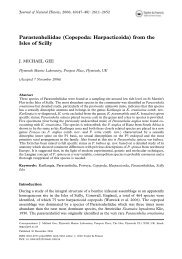An Updated Classification of the Recent Crustacea
An Updated Classification of the Recent Crustacea
An Updated Classification of the Recent Crustacea
Create successful ePaper yourself
Turn your PDF publications into a flip-book with our unique Google optimized e-Paper software.
Superfamily Majoidea<br />
Hendrickx (1995, and pers. comm.) brought our<br />
attention to <strong>the</strong> elevation <strong>of</strong> several majid subfamilies<br />
to familial rank, such as <strong>the</strong> elevation <strong>of</strong> some<br />
inachoid groups by Drach and Guinot (1983), who<br />
recognized as families <strong>the</strong> Inachidae and Inachoididae.<br />
We have followed Hendrickx’s recognition <strong>of</strong><br />
former majid subfamilies as families. To some degree,<br />
our treatment (and Hendrickx’s) <strong>of</strong> <strong>the</strong> majoid<br />
families follows <strong>the</strong> seven subfamilies proposed by<br />
Griffin and Tranter (1986) in <strong>the</strong>ir major revision<br />
<strong>of</strong> <strong>the</strong> Majidae <strong>of</strong> <strong>the</strong> Indo-West Pacific. Additional<br />
subfamilies have been proposed by o<strong>the</strong>r workers,<br />
including Števčić (1994), who disagreed with some<br />
<strong>of</strong> <strong>the</strong> subdivisions proposed by Griffin and Tranter<br />
(1986). Diversity <strong>of</strong> <strong>the</strong> former family Majidae is<br />
incredibly high, and recognition or treatment <strong>of</strong> <strong>the</strong><br />
majoids as a superfamily has been noted or suggested<br />
by many earlier workers (e.g., Guinot, 1978;<br />
Drach and Guinot, 1983; Števčić, 1994; Clark and<br />
Webber, 1991, among o<strong>the</strong>rs). M. Wicksten (pers.<br />
comm.) suggests that, if we elevate some <strong>of</strong> <strong>the</strong> former<br />
majid subfamilies to <strong>the</strong> family level, <strong>the</strong>n we<br />
should recognize also <strong>the</strong> family Oregoniidae<br />
Garth, 1958, and possibly also <strong>the</strong> Macrocheiridae<br />
Balss, 1929, ‘‘for consistency.’’ Indeed, Clark and<br />
Webber (1991) proposed recognition <strong>of</strong> both <strong>of</strong><br />
<strong>the</strong>se families based on a reevaluation <strong>of</strong> <strong>the</strong> larval<br />
features <strong>of</strong> Macrocheira and suggested that extant<br />
majoids be partitioned among four families: Oregoniidae,<br />
Macrocheiridae, Majidae, and Inachidae.<br />
Larval morphology indicates <strong>the</strong> distinct nature,<br />
and presumed monophyly, <strong>of</strong> <strong>the</strong>se groups as well<br />
(Pohle and Marques, 2000). We have not taken that<br />
step here, feeling that knowledge <strong>of</strong> larval majoids<br />
is still ra<strong>the</strong>r incomplete, and we recognize here<br />
only <strong>the</strong> families Epialtidae, Inachidae, Inachoididae,<br />
Majidae, Mithracidae, Pisidae, and Tychidae.<br />
Concerning phylogeny among <strong>the</strong> higher (heterotrematous)<br />
crabs, Rice (1983:326) depicts <strong>the</strong> Majidae<br />
(our Majoidea) as basal to <strong>the</strong> primitive xanthid<br />
stock, which in turn gives rise to all o<strong>the</strong>r crab<br />
families and superfamilies. A recent study based on<br />
larval characters (Pohle and Marques, 2000) suggests<br />
that, within <strong>the</strong> Majoidea, <strong>the</strong> Oregoniinae<br />
clade is most basal among those majoid families (or<br />
subfamilies) for which larval morphology is<br />
known.<br />
Superfamily Hymenosomatoidea<br />
According to Guinot and Richer de Forges (1997),<br />
members <strong>of</strong> <strong>the</strong> family Hymenosomatidae (sole<br />
member <strong>of</strong> this superfamily) are thought to be<br />
‘‘highly advanced Heterotremata and not Thoracotremata’’<br />
(Guinot and Richer de Forges, 1997:<br />
454, English abstract). In addition, Guinot and<br />
Richer de Forges (1997) revive <strong>the</strong> idea that <strong>the</strong><br />
closest relatives <strong>of</strong> <strong>the</strong> hymenosomatids may lie<br />
among <strong>the</strong> majoid family Inachoididae. The unusual<br />
sperm morphology <strong>of</strong> one species <strong>of</strong> <strong>the</strong> family,<br />
as reported by Richer de Forges et al. (1997),<br />
would seem to exclude <strong>the</strong> Hymenosomatidae from<br />
<strong>the</strong> Thoracotremata, and even casts doubts as to<br />
<strong>the</strong> family’s inclusion in <strong>the</strong> Heterotremata.<br />
Superfamily Par<strong>the</strong>nopoidea<br />
The superfamily Mimilambroidea and its sole family<br />
Mimilambridae, both originally erected by Williams<br />
(1979) to contain Mimilambrus, have been<br />
removed following <strong>the</strong> suggestion <strong>of</strong> Ng and Rodriguez<br />
(1986) that Mimilambrus can be accommodated<br />
within <strong>the</strong> Par<strong>the</strong>nopidae. Hendrickx (1995)<br />
again alerted us to <strong>the</strong> fact that several former subfamilies<br />
<strong>of</strong> crabs (in this case, former par<strong>the</strong>nopid<br />
subfamilies) had been suggested to be deserving <strong>of</strong>,<br />
or had actually been elevated to, family rank as<br />
long ago as 1978 (Guinot, 1978). Although several<br />
authors (e.g., Hendrickx, 1999) have attributed <strong>the</strong><br />
family name Daldorfiidae to M. J. Rathbun, we<br />
have found no indication that <strong>the</strong> taxon was recognized<br />
by her. Ng and Rodriguez (1986) recognized<br />
<strong>the</strong> suggested par<strong>the</strong>nopoid groupings <strong>of</strong><br />
Guinot as valid families and first used <strong>the</strong> names<br />
Daldorfiidae [as Daldorfidae] and Dairidae, and we<br />
have attributed <strong>the</strong>se families to <strong>the</strong>m. We have followed<br />
Guinot (1978) and Ng and Rodriguez (1986)<br />
and recognize <strong>the</strong> families Aethridae, Dairidae,<br />
Daldorfiidae, and Par<strong>the</strong>nopidae within a superfamily<br />
Par<strong>the</strong>nopoidea, although Hendrickx (1995)<br />
stopped short <strong>of</strong> treating all <strong>of</strong> <strong>the</strong>se as valid families.<br />
Superfamily Retroplumoidea<br />
The family Retroplumidae was given its own superfamily<br />
by Saint Laurent (1989), and its placement<br />
among <strong>the</strong> Heterotremata is based on Saint<br />
Laurent (1989) and Guinot (pers. comm.)<br />
Superfamily Cancroidea<br />
The family Cheiragonidae Ortmann, 1893, containing<br />
<strong>the</strong> genera Telmessus and Erimacrus (formerly<br />
treated by most workers as atelecyclids), was<br />
resurrected and redescribed by Števčić (1988), and<br />
this has been followed by Peter Ng (1998, and pers.<br />
comm., 1997; see also Schweitzer and Salva, 2000),<br />
and so we have included it here as well.<br />
Superfamily Portunoidea<br />
The freshwater family Trichodactylidae has now<br />
been placed in this superfamily, where it joins <strong>the</strong><br />
portunids and geryonids, based primarily on a recent<br />
morphological analysis (Sternberg et al., 1999;<br />
see also below under Potamoidea). Fundamental<br />
differences between trichodactylids and o<strong>the</strong>r freshwater<br />
crabs were recognized by several earlier<br />
workers. Rodriguez (1982, 1986, 1992), Magalhães<br />
and Türkay (1996a–c), Sternberg (1997),<br />
Sternberg et al. (1999), Christoph Schubart (pers.<br />
comm.), and Spears et al. (2000) all acknowledge<br />
<strong>the</strong> unique position <strong>of</strong> <strong>the</strong> Trichodactylidae and all<br />
consider <strong>the</strong> family monophyletic. The hypo<strong>the</strong>sis<br />
52 Contributions in Science, Number 39 Rationale











